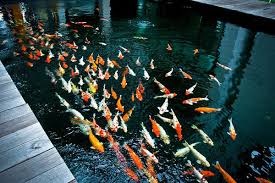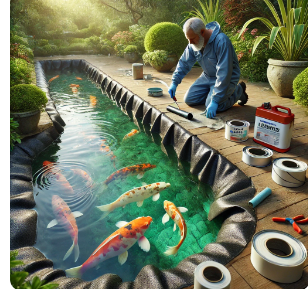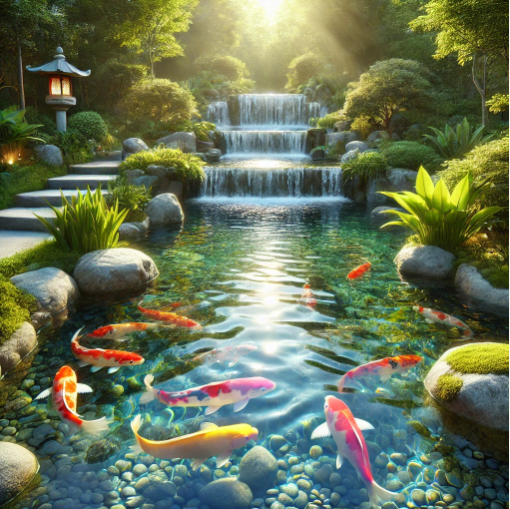Koi fish breeding is an exciting but challenging process that requires careful planning, patience, and the right environment. Whether you’re breeding koi for personal enjoyment or for selling high-quality koi, understanding the proper techniques will increase your success rate and produce healthy, vibrant fish.
In this guide, we’ll cover everything you need to know about breeding koi fish, from selecting the right breeding pair to caring for baby koi (fry).
1. When is the Best Time to Breed Koi Fish?
Koi fish naturally spawn in spring when the water temperature reaches 65–75°F (18–24°C). This is when they become more active and start their breeding behaviors.
If you’re breeding koi in a controlled environment (indoor tanks or ponds), you can manually adjust the water temperature to encourage spawning at the right time.
2. Selecting the Best Koi for Breeding
Not all koi are ideal for breeding. To produce high-quality offspring, you need to select koi with strong genetics, vibrant colors, and good body shape.
A. Choosing the Breeding Pair
✔ Healthy, mature koi (3-5 years old) for best fertility
✔ Well-defined patterns and strong colors
✔ No visible deformities or health issues
✔ Choose one male and one female (or multiple males for better fertilization)
🔹 How to Identify Male vs. Female Koi?
- Males: Slimmer bodies, rough pectoral fins, and chase females during spawning.
- Females: Rounder bodies, larger size, and softer bellies (full of eggs).
📌 Pro Tip: Breeding high-quality koi (like Kohaku, Sanke, or Showa) will increase the chances of producing desirable fry.
3. Preparing the Breeding Pond or Tank
Koi naturally spawn in shallow waters with plenty of plants or spawning mats to lay eggs. You need to replicate these conditions to encourage successful breeding.
A. Breeding Pond Setup
✔ Pond Size: At least 1000 gallons for breeding koi
✔ Water Temperature: Maintain 65–75°F (18–24°C)
✔ Spawning Mats: Use soft materials like aquatic plants, artificial spawning brushes, or mop-like breeding mats
✔ Good Water Quality: Clean, well-oxygenated water is essential
📌 Pro Tip: Use a separate breeding pond or tank to avoid adult koi eating the eggs or fry after spawning.
4. The Spawning Process
Once the breeding pair is introduced to the spawning pond, they will begin their mating behavior, which includes chasing, nudging, and splashing.
A. Signs of Koi Ready to Spawn
✔ Males chase females aggressively
✔ Females look bloated with eggs
✔ Increased activity and splashing
B. How Do Koi Lay Eggs?
- The female koi releases thousands of eggs onto the spawning mats.
- The male koi then fertilizes the eggs by releasing milt (sperm).
- The eggs stick to plants or breeding mats and hatch within 4-7 days, depending on water temperature.
📌 Important: After spawning, remove the adult koi to prevent them from eating the eggs.
5. Caring for Koi Fry (Baby Koi)
Once the eggs hatch, the tiny baby koi (fry) will need a safe and healthy environment to grow.
A. Fry Pond Setup
✔ Shallow tank or pond with gentle filtration
✔ Keep water temperature stable (70–75°F)
✔ Provide gentle aeration and frequent water changes
B. What to Feed Baby Koi?
✔ First few days: The fry will absorb their yolk sac for nutrition.
✔ After 4–5 days: Start feeding infusoria, liquid fry food, or finely crushed flakes.
✔ After 2 weeks: Feed baby brine shrimp, powdered koi food, or daphnia.
✔ After 4–6 weeks: Upgrade to small pellets or crumbled koi food.
📌 Pro Tip: Keep fry in a separate pond or tank until they grow large enough to avoid being eaten by larger koi.
6. Selecting & Growing the Best Koi
As the koi fry grow, some will develop stronger colors and patterns than others. To ensure the best quality koi, breeders often cull weaker or less desirable koi.
A. When to Cull Koi Fry?
✔ First culling: At 4–6 weeks, remove weak, deformed, or dull-colored fry.
✔ Second culling: At 2-3 months, select koi with the best patterns.
✔ Final selection: After 6 months, only keep high-quality koi.
📌 Pro Tip: Culling is essential to maintain a healthy koi population and enhance the quality of the remaining fish.
7. Common Mistakes to Avoid
✔ Breeding unhealthy koi – Always select strong, disease-free koi.
✔ Not providing enough space – Overcrowding can lead to poor growth and water quality issues.
✔ Skipping culling – Keeping too many weak koi will reduce the overall quality of your pond.
✔ Poor water quality – High ammonia and nitrate levels can be fatal for fry.
8. How Long Does It Take for Koi to Grow?
Koi grow slowly over the years, but with the right care, they can reach 2 feet or more.
✔ 3 months: 1–2 inches
✔ 6 months: 3–4 inches
✔ 1 year: 6–10 inches
✔ 3 years: 12–24 inches
✔ 5+ years: 24–36 inches (depending on genetics and care)
📌 Pro Tip: Feeding high-quality koi food and maintaining good water quality will help koi grow faster and develop vibrant colors.
Final Thoughts
Breeding koi fish is a rewarding process that requires patience, planning, and the right environment. By selecting high-quality parents, maintaining a clean pond, and providing proper care for the fry, you can successfully breed beautiful and healthy koi.
Key Takeaways:
✔ Select healthy, mature koi with strong colors and patterns.
✔ Set up a separate breeding pond with spawning mats.
✔ Remove adult koi after spawning to protect the eggs.
✔ Feed fry specialized food and maintain clean water.
✔ Cull weak koi to improve overall quality.
With the right techniques, you can produce high-quality koi that will thrive for years! 🐠✨
📌 Are you planning to breed koi fish? Share your experiences in the comments below!




